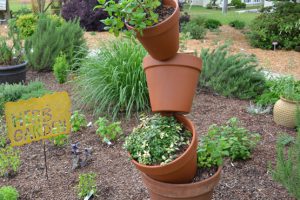Herbs are like people; each herb has its own personality. Some herbs have bold flavors and should be used with care while others are mild and can be used more freely. View Shopping for Health: Herbs and Spices for more about this.
Herbs can be divided into two categories. Accent herbs and herbs that add character to dishes. Parsley, chives, and dillweed are a few of the accent herbs. They are milder in flavor and are often combined within the same recipe. The character herbs; basil, marjoram, rosemary, bay leaves, thyme, sage, and tarragon add dominant flavor to dishes.
A little heat releases the flavor of herbs. Herbs are bitter, however, when cooked too much. Add accent herbs during the last few minutes of cooking time. Character herbs, such as bay leaves, can withstand longer cooking times and usually are added at the beginning of the cooking process.
When selecting fresh herbs, look for plants with an all-over green color. Yellowing indicates old plants, while black, watery areas are a sign of bruising.
To refrigerate fresh herbs for future use, rinse herbs under cold water, pat dry, wrap in paper toweling and refrigerate in a plastic bag. To use, just cut or pull off leaves. Most refrigerated herbs will retain freshness for up to four days to a week.
Herbs can be frozen or dried for longer storage. To freeze fresh herbs, wash herbs, pat dry and freeze in airtight bags or containers. Frozen herbs should be thawed just before use. Fresh herbs can be dried for later use.
When experimenting with a new herb, pull off a leaf and crush it, let it warm in your hand. If it has a delicate aroma you can add more. If it is strong and pungent, use it sparingly. It is always easier to add more of an herb than subtract.
Dried herbs are more concentrated. When cooking with dried herbs use one third of the dried leaves to substitute for the fresh. One teaspoon of dried leaves is equal to one tablespoon of fresh. The fresh leaves are more pungent than the dried.
Cooking with Herbs
Try these herb blends to enhance the flavor of beef, poultry, and seafood dishes.
Salt Free Blend
1 Tablespoon mustard powder
2 teaspoons parsley
2 teaspoons onion powder
2 teaspoons thyme
1 Tablespoon garlic powder
2 teaspoons dill weed
2 teaspoons savory
2 teaspoons paprika
1 teaspoons lemon peel
Garden Blend
3 Tablespoons dried parsley
3 Tablespoons dried basil
3 Tablespoons dried thyme
3 Tablespoons dried marjoram
3 Tablespoons dried rosemary
3 Tablespoons dried chives
3 Tablespoons paprika
½ teaspoon garlic powder
“What is paradise, but a garden of herbs full of pleasure and nothing there but delights”
William Lawson, 1617
- What’s Brewing – Tea – National Tea Day - April 19, 2024
- Stress Around the Clock - March 22, 2024
- WOW! Your Guests with Holiday Baking - December 15, 2022

